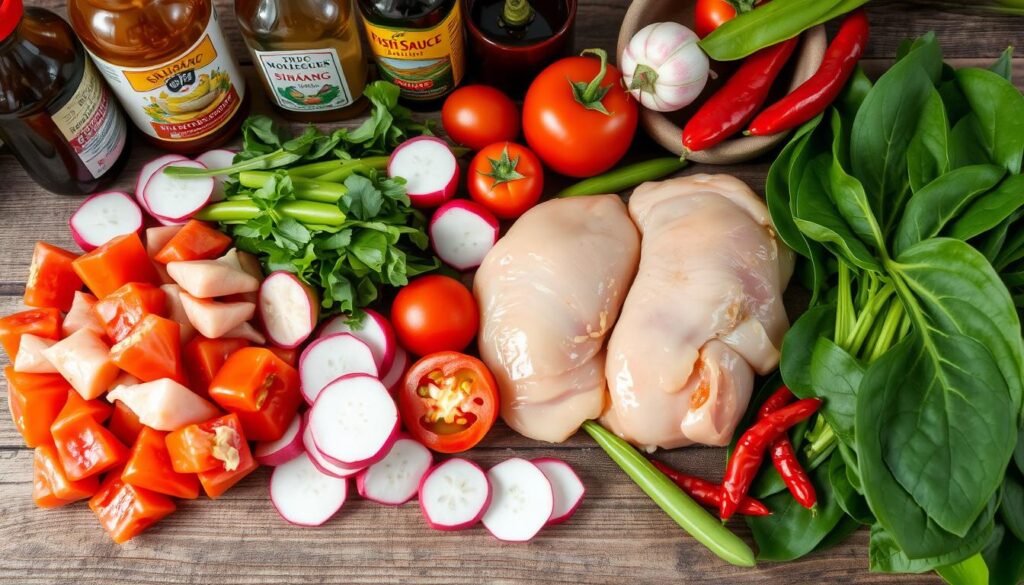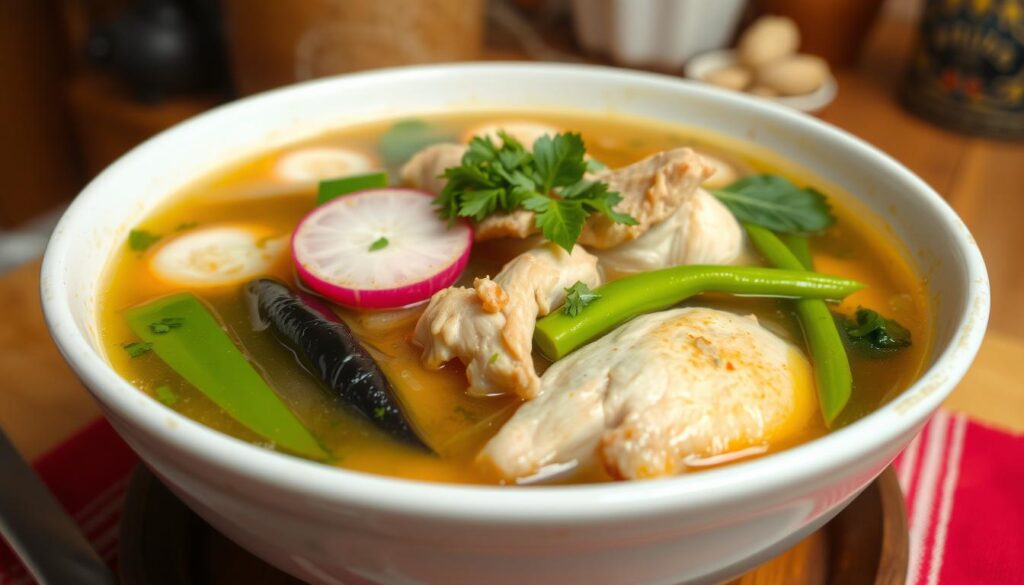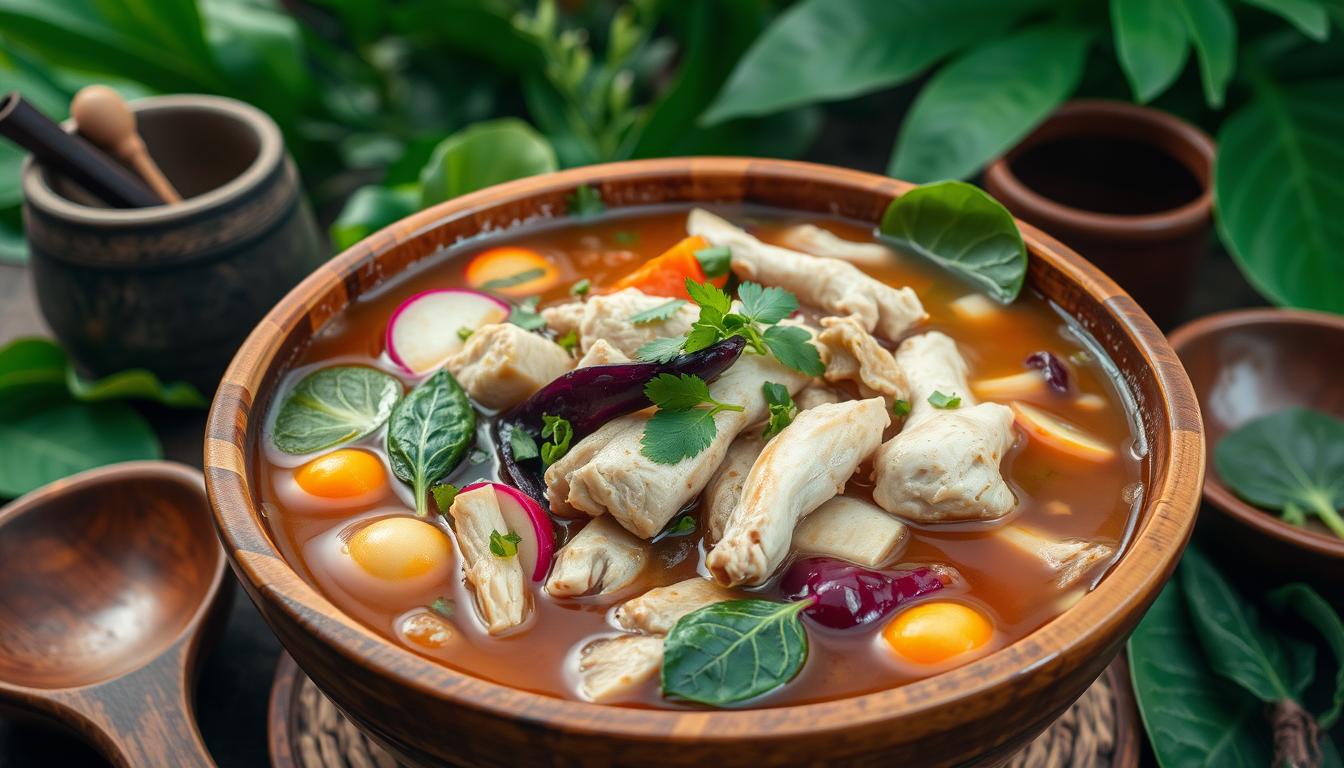Exploring Filipino cuisine, you’ll find the traditional sinigang recipe. It’s known for its sour and savory taste. Passed down through generations, its variations are a staple in Filipino cooking. If you want to make the best Sinigang with chicken, you’re in the right spot.
Making a tasty sinigang recipe needs the right ingredients and techniques. In this article, we’ll dive into the traditional sinigang recipe. We’ll explore the secrets to cooking the best Sinigang with chicken.
Key Takeaways
- Understanding the traditional sinigang recipe is key to making an authentic dish.
- Choosing the right ingredients is vital for a delicious Filipino sinigang recipe.
- Cooking techniques greatly affect the flavor and texture of the sinigang recipe.
- Trying different variations of the traditional sinigang recipe can bring new flavors.
- Appealingly presenting the dish can enhance the dining experience.
- Mastering sinigang with chicken takes practice and patience.
- Following a tested sinigang recipe can help you get the perfect flavor balance.
Understanding the Traditional Sinigang Recipe
To truly appreciate the authentic sinigang recipe, it’s key to know its roots in Filipino cuisine. Influenced by Chinese, Spanish, and Malay cultures, it has a unique taste. This taste reflects the country’s rich history.
Exploring an easy sinigang recipe, you’ll find key ingredients. These include the sour tamarind broth, sweet vegetables, and savory protein.
The traditional recipe mirrors Filipino culture and history. Tamarind broth’s sourness is balanced by sweet vegetables and savory protein. For an authentic recipe, choose fresh vegetables, protein like chicken or pork, and tamarind broth.
History of Sinigang in Filipino Cuisine
Sinigang has been a cherished part of Filipino cuisine for generations. Its origins date back to the pre-colonial era. Over time, different regions have developed their versions.
These variations use different souring agents and add various vegetables and proteins. Sinigang showcases the country’s rich culinary diversity.
Why Chicken Sinigang is a Popular Variation
Chicken sinigang is a favorite for many. Chicken makes the dish more affordable and accessible. It also pairs well with the sour tamarind broth.
When making an easy sinigang recipe, consider using chicken. It adds a delicious twist to the traditional dish.
Key Flavor Profiles of Authentic Sinigang
The authentic sinigang has three main flavors: sour, sweet, and savory. To get these flavors right, choose the right ingredients and balance them well. With an authentic recipe, you can create a dish that truly showcases the unique taste of sinigang.
Essential Ingredients for Perfect Chicken Sinigang
To make the best sinigang recipe, you need the right ingredients. The base is the protein, like chicken, pork, or shrimp. For chicken sinigang, use boneless chicken cuts, such as thighs or legs.
You also need various vegetables, like tomatoes, onions, and bok choy. The tamarind broth is key, adding sourness balanced by sweet veggies and savory protein. Don’t forget fish sauce, salt, and black pepper.
Here are the essential sinigang ingredients you’ll need:
- 1 pound boneless chicken cuts
- 2 medium tomatoes, diced
- 1 medium onion, diced
- 2 cups bok choy, chopped
- 1 cup tamarind broth
- 2 tablespoons fish sauce
- 1 teaspoon salt
- 1/2 teaspoon black pepper
With these ingredients, you can create a delicious chicken sinigang. It’s sure to impress your family and friends. Use fresh ingredients and follow the best recipe for a perfect dish.
Secret 1: Choosing the Right Souring Agent
When making sinigang, the souring agent is key. It’s what gives the dish its unique flavor. Knowing the different types of souring agents is important if you want to make a great sinigang.
Types of Tamarind Options
Tamarind is the classic choice for sinigang. You can pick tamarind paste or fresh tamarind fruit. For a recipe, use 1-2 tablespoons of paste or 1-2 cups of fresh tamarind for every 4 cups of broth.
Alternative Souring Ingredients
Calamansi, kamias, or guava can also be used. They give sinigang a different taste. Just remember to adjust the amount based on your taste.
Proper Ratios for Balanced Sourness
To get the flavor right, use the right amount of souring agent. A good rule is 1-2 tablespoons of paste or 1-2 cups of fresh tamarind for every 4 cups of broth. This way, you’ll have a delicious sinigang.
| Souring Agent | Amount | Broth Ratio |
|---|---|---|
| Tamarind Paste | 1-2 tablespoons | 1:4 |
| Fresh Tamarind Fruit | 1-2 cups | 1:4 |
Secret 2: The Perfect Chicken Cuts for Your Sinigang Recipe
Choosing the right chicken cuts is key for a tasty sinigang dish. You can pick boneless, skinless chicken breasts or thighs. Cut them into small pieces or leave them whole, based on your preference. Some folks also mix in pork sinigang recipe with chicken. The goal is to pick cuts that soak up the sinigang flavors well and cook evenly.
For the best taste, think about these sinigang ingredients and their roles:
- Protein source: chicken or pork
- Souring agent: tamarind or other alternatives
- Vegetables: various options like tomatoes, onions, and leafy greens
- Broth: a mix of water, sinigang ingredients, and seasonings
Trying out different sinigang recipes, like pork sinigang recipe, shows that the right chicken cuts matter a lot. By picking the best cuts and mixing them with the right ingredients, you’ll make a delicious sinigang dish.

Cooking sinigang is about finding the right balance. Choosing the right chicken and ingredients makes your dish tasty and pretty. So, feel free to try different combinations to find what you like best.
| Chicken Cut | Description | Recommended Use |
|---|---|---|
| Boneless, skinless chicken breast | Tender and lean | Best for sinigang recipes where chicken is the main protein |
| Boneless, skinless chicken thighs | Flavorful and moist | Ideal for sinigang recipes where chicken is cooked with other ingredients |
Secret 3: Vegetable Selection and Preparation
Choosing the right vegetables is key to a tasty sinigang recipe. You need veggies that add sweetness, texture, and flavor. Tomatoes, onions, bok choy, and long beans are great choices. They’re tasty and easy to find.
Cut your veggies into small pieces for even cooking. The way you cut them is also important. You want to keep their texture and flavor.
Traditional Vegetables Used
- Tomatoes: add natural sweetness and acidity to your sinigang recipe
- Onions: add a pungent flavor and texture to your sinigang soup recipe
- Bok choy: adds a delicate flavor and crunchy texture to your sinigang recipe
- Long beans: add a sweet and slightly crunchy texture to your sinigang soup recipe
Proper Cutting Techniques
Using the right cutting techniques is important. Cut your veggies into uniform pieces for even cooking. Avoid over-cutting to keep flavor and texture.
Cooking Order for Vegetables
The order in which you cook your veggies matters. Start with onions, then tomatoes, bok choy, and long beans. This way, each veggie is cooked just right, making your sinigang soup delicious and balanced.
Secret 4: Mastering the Broth Base
To make a great sinigang dish, you must perfect the broth base. It’s the heart of this Filipino recipe. The base is made with tamarind, fish sauce, salt, and black pepper. You can tweak it to fit your taste.
One top tip is to make the broth base early and keep it in the fridge for up to 3 days. This lets the flavors mix well, making the broth richer. Feel free to add other souring agents or spices to make it your own.
Here are some tips to master the broth base:
- Choose top-notch sinigang ingredients, like fresh tamarind and fish sauce, for a deep flavor.
- Play with the sourness level to your liking, whether you want it stronger or milder.
- Try adding spices like black pepper or bay leaves to deepen the broth’s taste.

Mastering the broth base is key to a tasty sinigang dish. Balance the flavors and adjust the seasoning as you like. Don’t hesitate to try new ingredients to make it your own.
Secret 5: Timing Your Ingredients
Learning to make sinigang means knowing when to add each ingredient. The recipe asks you to add things in order. This way, each part is cooked just right. It makes your sinigang taste and feel balanced.
To get good at sinigang, follow these steps:
- First, cook your protein, like chicken, until it’s soft and done.
- Then, add your veggies, like tomatoes and greens, and cook until they’re tender but crisp.
- Season with a souring agent, like tamarind, and adjust the taste as you like.
Sinigang usually cooks for 30-40 minutes. This time can change based on what you use and how much. By following these steps and adjusting the time, you’ll make a tasty sinigang dish.
Don’t worry if your first sinigang isn’t perfect. Making it is a skill that takes practice. Keep trying, and you’ll soon be great at making sinigang. Your family and friends will love it.
| Ingredient | Cooking Time |
|---|---|
| Chicken | 15-20 minutes |
| Vegetables | 10-15 minutes |
| Souring Agent | 5 minutes |
Secret 6: Achieving the Right Consistency
To perfect your sinigang soup recipe, getting the right consistency is key. You want the broth to be thick and full of flavor but not too thick. The secret to a great sinigang is finding the perfect balance, and consistency is no exception.
Adjusting the broth’s consistency is easy. For a thicker broth, use less water or add more tomatoes or veggies. For a lighter broth, add more water or use fewer ingredients.
Broth Thickness Guidelines
Here are a few suggestions to help you achieve the perfect consistency:
- Start with a small amount of broth and adjust to taste.
- Use a mix of water and tamarind broth for authentic flavor.
- Avoid overcooking, as it can make the broth too thick.
Adjusting Seasonings
To boost your sinigang’s flavor, tweak the seasonings. Fish sauce, salt, and black pepper are common additions. You can also try patis or calamansi for a more authentic taste.

By following these tips and adjusting seasonings, you can make a delicious sinigang soup. Remember, the secret to a great sinigang is balance and harmony. Feel free to experiment and discover the blend that suits you best.
Secret 7: Serving and Presentation Tips
When serving your sinigang recipe, presentation is key. You want to impress your guests. A thoughtfully plated dish can elevate the enjoyment of a meal. Start by serving it with steamed rice, which balances the sourness.
Adding fresh herbs like basil or cilantro can add color and freshness. A good sinigang recipe is not just about ingredients. It’s also about how you present it.
Consider adding fried garlic or chili peppers for extra flavor and texture. Here are some tips to keep in mind:
- Incorporate a mix of vibrant colors to make the dish more visually enticing
- Enhance the texture by adding crunchy elements such as fried garlic or roasted peanuts
- Feel free to unleash your creativity and add your unique personal touches
By following these tips, you can make a sinigang dish that’s not only delicious but also looks great. So go ahead, get creative, and show off your sinigang recipe with pride!
Common Mistakes to Avoid When Making Sinigang
Learning to make sinigang can be tricky. Knowing common mistakes helps you avoid them. This way, you can make a perfect sinigang dish.
A common mistake is failing to properly manage the cooking temperature. Proper temperature control is key to a great broth.
Here are some mistakes to watch out for:
- Using too much or too little souring agent can mess up the taste.
- Not balancing the ingredients can make the dish taste off.
- Not adjusting the seasonings can make it too salty or too bland.
To avoid these mistakes, stick to a good sinigang recipe. Make changes as you see fit. This way, you can make a delicious sinigang dish that everyone will love.
With practice and patience, you’ll get better at making sinigang. You’ll be able to enjoy this traditional Filipino dish at home. Always use fresh ingredients and adjust the seasonings to your liking. Happy cooking!
| Mistake | Effect on the Dish | Solution |
|---|---|---|
| Temperature control issues | Overcooking or undercooking | Monitor the temperature closely |
| Unbalanced ingredients | Lack of harmony in flavor and texture | Adjust the ingredients to achieve balance |
| Poor seasoning | The dish is too salty or too bland | Adjust the seasonings to taste |
Conclusion: Mastering Your Homemade Chicken Sinigang
Making homemade Chicken Sinigang takes practice, patience, and detail. Follow the 7 secrets in this article to make a delicious, authentic Sinigang. Experiment with ingredients and seasonings to find your favorite flavors.Feel free to experiment and embrace mistakes as part of the learning process.
The secret to perfect Sinigang is knowing the traditional flavors and techniques. With creativity and love, you can make Sinigang’s vibrant, tangy taste in your kitchen. So, get ready to make the best Chicken Sinigang you’ve ever had.

